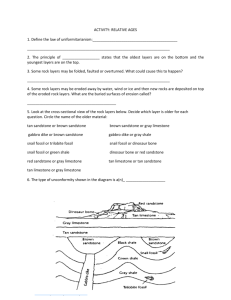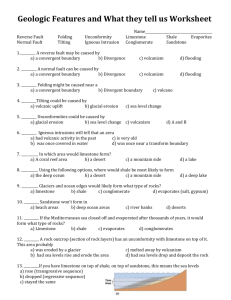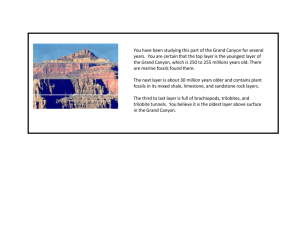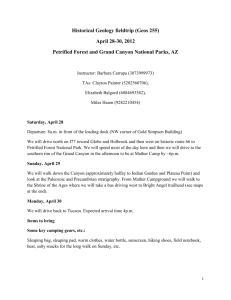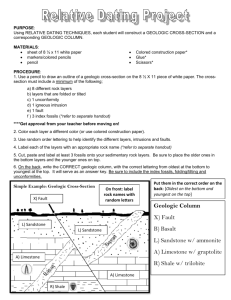Grand Canyon Activity Key
advertisement
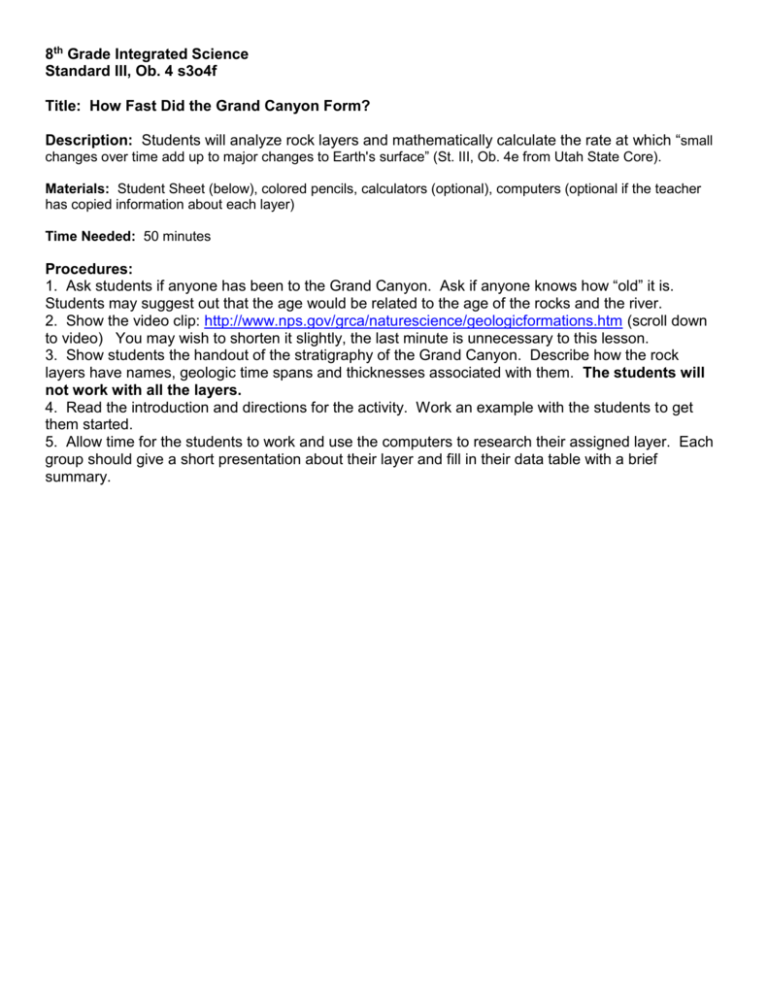
8th Grade Integrated Science Standard III, Ob. 4 s3o4f Title: How Fast Did the Grand Canyon Form? Description: Students will analyze rock layers and mathematically calculate the rate at which “small changes over time add up to major changes to Earth's surface” (St. III, Ob. 4e from Utah State Core). Materials: Student Sheet (below), colored pencils, calculators (optional), computers (optional if the teacher has copied information about each layer) Time Needed: 50 minutes Procedures: 1. Ask students if anyone has been to the Grand Canyon. Ask if anyone knows how “old” it is. Students may suggest out that the age would be related to the age of the rocks and the river. 2. Show the video clip: http://www.nps.gov/grca/naturescience/geologicformations.htm (scroll down to video) You may wish to shorten it slightly, the last minute is unnecessary to this lesson. 3. Show students the handout of the stratigraphy of the Grand Canyon. Describe how the rock layers have names, geologic time spans and thicknesses associated with them. The students will not work with all the layers. 4. Read the introduction and directions for the activity. Work an example with the students to get them started. 5. Allow time for the students to work and use the computers to research their assigned layer. Each group should give a short presentation about their layer and fill in their data table with a brief summary. How Fast Did the Grand Canyon Form? Name______________________________ Hour Knowledge Tag s3o4f Introduction: A view of the Grand Canyon is… well… grand! If you have ever been there, you know that is true. The formation of such an impressive feature on Earth’s crust takes a long time and a lot of slow changes. In this activity, you will investigate the amount of time it took for the rocks of the canyon to form and the river to wear away a canyon through them. The formation of the canyon depended on two things: the powerful river erosion and the uplift of the rock layers found in this area. Get out your calculator; let’s see how long it took. Prediction: How long did it take? Materials: colored pencils, layers diagram, calculator, computers Procedures: 1. Begin by calculating how quickly the rocks formed in each layer. Subtract the starting and ending times in the time span and put that number in the time column. 2. Divide the amount of time by the thickness in meters. . 4. Pick 4 layers (one for each person in your group) to research in more detail. These sites can help: http://www.bobspixels.com/kaibab.org/geology/gc_layer.htm#kl http://www.classzone.com/books/earth_science/terc/content/investigations/es2906/es2906page11.cf m Wikipedia has a page for each rock layer 6.) Or use the information provided. 5. Write your information in the correct spot on your data sheet. Report three important characteristics about your layer to the class. Data: Name of layer Kaibab Limestone Thickness of layer 90 m Time span (million years ago) 248-270 Time for Layer to Form Time per meter Characteristics of the layer The Kaibab limestone is gray and sandy and can be up to 320' thick. It has lots of fossils which include corals, squids, sponges, and shellfish. It took about Toroweap Formation 60 m Cococino Sandstone 100 m 273-275 Hermit Shale 150 m 275-290 200 m 290-323 Surprise Canyon Formation 70 m 322-323 Redwall Limestone 180 m 324-354 Temple Butte limestone 75m 354-417 300 m 510-525 unconformity Supai Group unconformity Tonto Group 270-273 3,000,000 yrs 50,000 yrs/1 meter Yellow and red sandstone Fossils of sharks teeth corals and sponges. 1,000,00 14,285 Sandstone, conglomerate y yrs/1m Total Canyon 1,600 m 0-2 billion WRAP UP QUESTIONS 1. 6,000,000 years ago, the Colorado River began to cut into the rock layers as they were uplifted. What was the rate that the river erosion cut through the 1,600 m of rock layers? 3750 yr/1m 2. Why did some rock layers form more quickly than others? they are different types of rocks and had different rates and different thicknesses 3. What does an unconformity indicate? tons of erosion and lost record of the rock 4. What happened to the rocks before the Great Unconformity? they were uplifted/tilted/folded-ancient mountains 5. The Zoroastor Granite (17 and 18 on the color resource) is not a sedimentary layer of rock. What clues in the stratigraphy diagram show that it is an igneous rock? it is not a layer looks globular-intrusion 6.) Come up with a new question about the formation of the Grand Canyon and use your resources to answer it. 1.) Where did the sediments from the great unconformity end up? 2.) Did it always used to be a desert? 3.) What kind of paleoenviroment was here? 4.) How did the changing earth affect changing animals/organisms. Conclusion (your choice) EXTRA CREDIT 1.) Write a 50 word summary of what you learned from this activity. Use the Step-Up-To-Writing (green, yellow, red) method to develop a thesis/topic sentence and label each sentence. 2.) Draw a picture/or thinking map of what you learned from this activity. 3.) Use the computer and ask 2 new extension questions and answer them. Grand Canyon Resource Information Permian Pennsylvanian Mississippian Devonian Cambrian Early Precambrian Kaibab Limestone Gray, sandy, massive, limestone up to 320' thick. Abundant fossils include corals, squids, sponges, and shellfish. Toroweap Formation Red and Yellow sandstones at the top and bottom of the formation, and some limestone between. Common fossils include corals, sponges, sharks teeth, and many kinds of clams, etc. Coconino Sandstone A massive white to buff colored, crossbedded sandstone about 400' thick. Almost all quartz, well sorted, fine grained, and displays huge aeolian crossbedding. Trails of quadrupeds, either reptiles or amphibians, have been found. Hermit Shale 100-300' thick, predominantly shale but also includes some sandstone strata. The sandstones have a deep red color. Some shale shows mudcracks and ripple marks. Fossils of plants, mostly ferns, and quadruped footprints have been found. Supai Group: 1000' thick series (group) of alternating red crossbedded sandstones Esplanade Sandstone and shales. The upper part of the group is non-marine and tracks of Wescogama Fm. quadrupeds are found on bed tops. These tracks are believed to have Manakacha Fm. been made by amphibians or primitive reptiles. Sediments appear in Watahomig Fm. many places to be thin beds spread over wide areas in short periods of time. The lower part of the Supai includes calcareous sandstones and shales which many believe are of marine origin. Surprise Canyon Variable deposits include sands and conglomerates. Cross bedding is Formation common but localized. Great horizontal variation in stratigraphy. ---- unconformity ---Redwall Limestone Thick to massively bedded, bluish-gray limestone beds up to 600' high. The most conspicuous cliff in the canyon. It appears red, but that is only on the surface. Various invertebrates, including corals, shellfish, and crinoids are present as fossils. Temple Butte A calcareous sandstone, lavender to purplish colored, 50-100' thick. Limestone Fossils of armored fish, corals, shellfish and snails have been found. ---- unconformity ---Tonto Group: The Muav Fm. is a gray to buff limestone 300-400' thick. At its base, Muav Limestone the limestone is interbedded with green shale and sandstone. At its Bright Angel Shale top the limestone grades into brown shales and sandstone. Tapeats Sandstone The Bright Angel Shale is mostly thinly bedded sandstones, but conspicuous micaceous shales and dolomite beds are also present. It varies between 350 and 400' thick. The Tapeats Sandstone is massive, coarse to medium grained, 100300' thick. It is generally chocolate brown, but is lighter colored in some areas. Cross beds are very common. Ripple marks, showing strong currents in one direction can also be found. Trilobite (an extinct early crab like critter) trails and worm tracks are present. Zoroaster Granite Although stratigraphically below the Vishnu Schist in many parts of ---- unconformity ---- the canyon, this intrusive igneous rocks is actually younger in age. Granites of this sort are associated with uplift and formation of mountain ranges. Vishnu Schist Oldest rock in the canyon. Formed by metamorphism of rocks that were originally sedimentary. The metamorphism occurred after the rocks were buried to great depth by mountain building. This formation is now tilted up and in places approaches vertical. Thickness unknown. From: http://www.bobspixels.com/kaibab.org/geology/gc_layer.htm#kl Paleozoic Strata o o o o o o o Kaibab Limestone - This layer averages about 250 million years old and forms the surface of the Kaibab and Coconino Plateaus. It is composed primarily of a sandy limestone with a layer of sandstone below it. In some places sandstone and shale also exists as its upper layer. The color ranges from cream to a greyish-white. When viewed from the rim this layer resembles a bathtub ring and is commonly referred to as the Canyon's bathtub ring. Fossils that can be found in this layer are brachiopods, coral, mollusks, sea lilies, worms and fish teeth. Toroweap Formation - This layer averages about 255 million years old and is composed of pretty much the same material as the Kaibab Limestone above. It is darker in color, ranging from yellow to grey, and contains a similar fossil history. Coconino Sandstone - This layer averages about 260 million years old and is composed of pure quartz sand, which are basically petrified sand dunes. Wedge-shaped cross bedding can be seen where traverse-type dunes have been petrified. The color of this layer ranges from white to cream colored. No skeletal fossils have yet to be found but numerous invertebrate tracks and fossilized burrows do exist. Hermit Shale - This layer averages about 265 million years old and is composed of soft, easily eroded shales which have formed a slope. As the shales erode they undermine the layers sandstone and limestone layers above which causes huge blocks to fall off and into the lower reaches of the Canyon. Many of these blocks end up in the side drainages and down on the Tonto Platform. The color of this layer is a deep, rust-colored red. Fossils to be found in this layer consist of ferns, conifers and other plants, as well as some fossilized tracks of reptiles and amphibians. Supai Formation - This layer averages about 285 million years old and is composed primarily of shale that is intermixed with some small amounts of limestone and capped by sandstone. The limestone features become more and more prominent in the western regions of the Canyon, leading one to believe that that region was more marine. The eastern portions where probably a muddy river delta that fed into an ancient sea. The color of this layer varies from red for the shale to tan for the sandstone caps. Numerous fossils of amphibians, reptiles and terrestial plants exist in the eastern portion which are replaced by marine fossils as you move westward. Redwall Limestone - This layer averages about 335 million years old and is composed of marine limestones and dolomites. This is probably the most prominent rock layer in the Canyon as it usually forms a sheer cliff ranging from 400-500 feet in height, which has become a natural barrier between the upper and lower regions of the Canyon. The only way though this barrier is in areas where the rock has faulted and broken apart to form a slope which can be climbed upon. The deep reddish color of this layer is caused by iron oxides leaching out of the layers above it and staining its outward face. Behind the reddish face the rock is a dark brownish color. Numerous marine fossils can be found in the Redwall Limestone including brachiopods, clams, snails, corals, fish and trilobites. Many caves and arches can also be seen in the Redwall. Temple Butte Limestone - This layer averages about 350 million years old and is composed of freshwater limestone in the east and dolomite in the west. In the eastern Grand Canyon this layer occurs irregularly and only then by way of limestone lenses that fill stream beds that have been eroded into the underlaying Mauv Limestone. Apart from these channels, which are quite large in places, the Redwall Limestone sits directly atop the Mauv Limestone. The Temple Butte Limestone is quite prominent, however, in the western regions and forms massive cliffs hundreds of feet high. The color of this layer ranges from purplish in the eastern regions to grey or cream colored in the west. The only fossils to be found in the eastern region are bony plates that once belonged to freshwater fish. In the western region there are numerous marine fossils. o Tonto Group - These layers average about 515 to 545 million years old. Muav Limestone - This layer averages about 515 million years old and is composed primarily of limestone that is separated by beds of sandstone and shale. The Mauv Limestone layer is much thicker in the western areas of the Canyon than it is in the east. Its color is grey and it does not have much in the way of fossils, some trilobites and brachiopods. Bright Angel Shale - This layer averages about 530 million years old and is composed primarily of mudstone shale. It is also interbedded with small sections of sandstone and sandy limestone. The retreat of the Canyon rim is attributed primarily to the erosion of this layer which forms the top of the Tonto Platform. The plateau is much wider in the eastern portions of the Canyon where the Bright Angel Shale contains less sand and is more easily eroded. The color of this layer varies with its composition but it is mostly various shades of green with some grey, brown and tan thrown in here and there. Fossils to be found in this layer consist of marine animals such as trilobites and brachiopods. Tapeats Sandstone - This layer averages about 545 million years old and is composed of medium-grained and coarse-grained sandstone. Ripple marks formed by ocean waves of an early Cambrian sea are common in the upper layer. The Tapeats is similar to the Redwall in that it forms a barrier between upper and lower reaches of the Canyon that can only be traversed where a fault has caused its collapse. The color of this layer is dark brown and it contains fossils of trilobites. brachiopods, and trilobite trails. Great Unconformity - This non-layer indicates an age in which no sediments can be found. It is indicative of a time when an advancing sea eroded away the sediments that should be here. Pre-Cambrian Unconformity - This non-layer represents a time where the mountains that had grown here were gradually eroded away to form a plain. Early Pre-Cambrian Rocks o Vishnu Schist and Zoroaster Granite - This layer averages about 1,700 to 2,000 million years old and consists of mica schist. These were originally sediments of sandstone, limestone and shale that were metamorphosed and combined with metamorphosed lava flows to form the schist. This layer along with the Zoroaster Granite were once the roots of an ancient mountain range that could have been as high as today’s Rocky Mountains. The mountains were eroded away over a long period of time and new sediments were they deposited over them by advancing and retreating seas. The color of this layer is dark grey or black.

